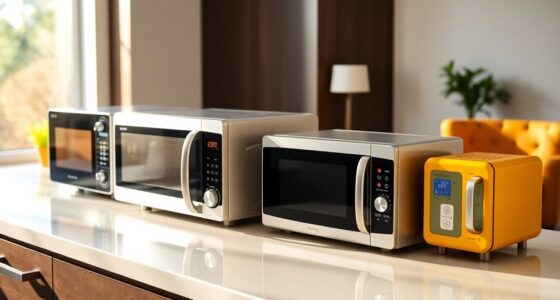I’ve researched the best elderly alert systems of 2025, and I’ve found some great options to guarantee safety and peace of mind. Devices like the FastHelp Medical Alert Device and Safety+ 4G System stand out for their reliability and features like fall detection and GPS tracking. Evaluating options like CallToU and SOS Micro can really make a difference in emergency situations. If you’re curious about what each system offers and how to choose the best one, there’s more to discover.
Key Takeaways
- The FastHelp Medical Alert Device 4G offers a cost-effective solution with no monthly fees and direct 911 connectivity for peace of mind.
- Safety+ 4G Medical Alert System features fall detection and GPS tracking, providing seniors with enhanced safety and 24/7 monitoring.
- CallToU Wireless Caregiver Pager facilitates effective communication between caregivers and seniors, with a range of over 500 feet for reliable alerts.
- SOS Micro 24/7 Medical Alert System is compact and lightweight, ensuring comfort and reliable 4G LTE connectivity for emergency monitoring.
- Consider systems with intuitive user interfaces and customizable settings to ensure ease of use for elderly individuals.
FastHelp Medical Alert Device 4G
The FastHelp™ Medical Alert Device 4G stands out as an ideal choice for elderly individuals who want a reliable safety solution without the burden of monthly fees. Weighing just 5.3 ounces and easily fitting in your hand, it connects directly to 911 wherever there’s cell service. The device’s rechargeable battery lasts for days, giving me peace of mind. While I appreciate its ease of use, I’ve noticed some users mention low volume during calls with 911 operators. Still, the lack of monthly fees and nationwide coverage make it a solid option for those seeking safety and independence.
Best For: The FastHelp™ Medical Alert Device 4G is best for elderly individuals seeking a reliable, cost-effective safety solution to maintain their independence.
Pros:
- No monthly fees provide significant savings over traditional medical alert systems.
- Direct connection to 911 ensures quick access to emergency services when needed.
- Compact and lightweight design makes it easy to carry and use.
Cons:
- Low volume issues reported by some users during communication with 911 operators.
- Durability concerns and complaints about adhesive residue from labels.
- Short battery life reported by some users, requiring frequent recharges.
Safety+ 4G Medical Alert System with Fall Detection and GPS
For seniors who want peace of mind while maintaining their independence, the Safety+ 4G Medical Alert System stands out with its fall detection and GPS capabilities. This lightweight device features a wireless call button, ensuring I can reach help anytime. I appreciate the 24/7 monitoring and quick emergency response—averaging under 9 seconds! The mobile app keeps my caregivers informed about my location and activity. Plus, with a first month free and straightforward subscription terms, I feel secure in my investment. Although some users report issues with customer service, the overall experience offers a solid sense of safety and reassurance.
Best For: Seniors seeking a reliable medical alert system that provides safety and independence through fall detection and GPS tracking.
Pros:
- 24/7 monitoring with an average response time of under 9 seconds ensures immediate assistance in emergencies.
- Lightweight and water-resistant design with multiple wearing options for comfort and convenience.
- Free caregiver app offers real-time insights into location, activity, and emergency alerts for family members.
Cons:
- Some users have reported issues with customer service and the activation process.
- Concerns regarding unclear subscription terms and perceived hidden fees after the first free month.
- App functionality issues have been noted, potentially impacting user experience.
CallToU Wireless Caregiver Pager Smart Call System
Designed with both caregivers and elderly individuals in mind, the CallToU Wireless Caregiver Pager Smart Call System stands out for its impressive 500+ feet range. This system includes two SOS call buttons and receivers, making it easy for seniors to alert caregivers when they need help. I love its portability; the button can be worn around the neck or secured with adhesive. With 55 ringtones and adjustable volume, it guarantees clear communication. Users rave about its reliability and ease of use, making it an essential safety tool. Plus, it’s waterproof and dustproof, perfect for any environment.
Best For: The CallToU Wireless Caregiver Pager Smart Call System is best for elderly individuals and caregivers seeking an effective communication tool for assistance in home care settings.
Pros:
- Reliable Communication: Ensures caregivers are alerted promptly when assistance is needed, enhancing safety.
- User-Friendly: Simple setup and operation, making it accessible for elderly users.
- Versatile Design: Waterproof and dustproof, suitable for various environments, and portable for ease of use.
Cons:
- Adhesive Issues: Some users reported potential problems with the adhesive for securing call buttons.
- Limited Outdoor Range: Effectiveness may be reduced in outdoor settings compared to indoor use.
- Battery Dependency: Requires batteries for call buttons, which may need replacement over time.
CallToU Caregiver Pager Wireless Call Button Alert System
Offering peace of mind for caregivers, the CallToU Caregiver Pager Wireless Call Button Alert System stands out as an essential tool for elderly individuals and those with disabilities. I love how easy it is to set up—just plug the receiver into an outlet, and you’re ready to go! The waterproof transmitter can be worn around the neck, making it accessible wherever you are. With over 500 feet of range, I can feel secure knowing help is just a button press away. The customizable volume and ringing tones offer flexibility, ensuring that I can find the perfect settings for any situation.
Best For: Individuals caring for elderly, disabled, or patients who need quick access to assistance in a variety of settings.
Pros:
- Easy setup: Just plug in the receiver, making it user-friendly for all ages.
- Customizable features: Offers multiple ringing tones and volume levels for personalized use.
- Wide operating range: Effectively covers over 500 feet, allowing freedom of movement within the home.
Cons:
- Limited to one receiver: The system includes only one receiver, which may not be sufficient for larger households.
- Dependence on battery: The transmitter requires battery power, which may need periodic replacement.
- Volume sensitivity: Some users may find the loudest setting too overwhelming for quieter environments.
SOS Micro 24/7 Medical Alert System for Seniors
The SOS Micro 24/7 Medical Alert System stands out as an ideal choice for seniors seeking peace of mind and safety. Its compact design, weighing less than 1.2 oz, allows me to wear it comfortably on my wrist or neck. With reliable Verizon 4G LTE connectivity, I can trust it to connect me to a USA-based monitoring center anytime. For just $29.95 a month, I get 24/7 emergency monitoring without hidden fees. The optional fall detection feature adds an extra layer of security, and I can track my device’s location and battery through a handy app.
Best For: Seniors seeking a reliable and easy-to-use medical alert system for enhanced safety and peace of mind.
Pros:
- Compact and lightweight design makes it comfortable to wear on the wrist, neck, or belt clip.
- 24/7 emergency monitoring with USA-based dispatch centers ensures quick response in case of emergencies.
- Optional fall detection feature provides added security and reassurance for seniors at risk of falls.
Cons:
- Monthly subscription fee may be a concern for those on a tight budget.
- False alarms can occur due to the device’s sensitivity, potentially leading to unnecessary dispatches.
- Limited water resistance (IP-67 rating) means it cannot be submerged in water, which may be a drawback for some users.
Caregiver Pager Wireless Call Buttons for Elderly Monitoring
For seniors who may struggle with mobility or health challenges, the caregiver pager wireless call buttons are an ideal solution for monitoring and assistance. This system includes two call buttons and a portable pager, allowing caregivers to manage other tasks while staying alert. The simple push-button operation is easy for seniors to use, whether worn around the neck or mounted nearby. With a range of up to 500 feet, it guarantees help is always within reach. Plus, the adjustable alarm settings provide peace of mind, making this system a reliable investment for elder care in any setting.
Best For: Seniors with mobility challenges or health conditions who require assistance and monitoring from caregivers.
Pros:
- Easy to use: Simple push-button operation allows seniors to call for help effortlessly.
- Versatile setup: Call buttons can be worn, mounted, or carried, providing flexibility in how they are used.
- Long-range effectiveness: Works effectively up to 500 feet, ensuring caregivers can respond quickly even from a distance.
Cons:
- Alarm sound limitations: Some users find the alarm too loud or aggressive, with few sound options available.
- Battery dependency: The system relies on batteries, which may require regular replacement after frequent use.
- Potential adjustment period: Seniors may need time to become accustomed to using the system effectively.
WiFi Smart Wireless Caregiver Pagers for Elderly Alert System
Connecting seamlessly to your smartphone, WiFi Smart Wireless Caregiver Pagers are perfect for families looking to enhance the safety of their elderly loved ones. These pagers come with two waterproof SOS buttons and a receiver that displays alerts on your phone. Thanks to 2.4GHz WiFi, you won’t face any monthly fees, making it budget-friendly. I love how easy they are to use—just press a button for an immediate alarm. With the smartphone app, I can track alerts from anywhere, which gives me peace of mind. This system’s convenience and reliability truly make it a thoughtful gift for caring families.
Best For: Families seeking an affordable and effective solution to ensure the safety of their elderly loved ones at home or in care facilities.
Pros:
- Easy to use: Just press the button for immediate alerts and notifications on your smartphone.
- Cost-effective: No monthly fees associated with the 2.4GHz WiFi connection, making it budget-friendly.
- Waterproof design: The SOS call button is IP55 rated, suitable for various environments.
Cons:
- Video tutorial discrepancies: Some users have noted that video tutorials do not match the product, leading to confusion.
- Limited range: The effectiveness may depend on the strength of the WiFi signal in the area.
- App compatibility concerns: Some users may experience issues with app functionality or setup when connecting multiple caregivers.
Daytech Wireless Caregiver Pager Call Button System for Elderly Monitoring
Designed with simplicity in mind, the Daytech Wireless Caregiver Pager Call Button System stands out as an ideal choice for elderly individuals who may have limited dexterity. This system includes two SOS call buttons and two watch pagers, providing reliable communication within a range of over 500 feet. I appreciate how easy it is to set up, and the splash-proof call button can be conveniently mounted where needed. The neck strap makes the pager accessible, ensuring quick alerts. With a one-year warranty and 24/7 support, I find comfort knowing that safety and independence are prioritized for my loved ones.
Best For: The Daytech Wireless Caregiver Pager Call Button System is best for elderly individuals seeking a reliable and easy-to-use communication system for emergencies.
Pros:
- Easy to use for individuals with limited dexterity, requiring only a simple button press to activate alerts.
- Versatile installation options with splash-proof call buttons that can be wall-mounted in critical areas like bathrooms.
- Strong customer support with 24/7 availability and a one-year warranty, ensuring peace of mind for families.
Cons:
- Programming can be challenging, as users may need to cycle through options for alerts and volume settings.
- Some users prefer the alert button over the watch pagers, indicating a lack of preference for one component.
- User interface improvements are suggested by a few users for a more streamlined selection process.
Safety+ 4G Medical Alert System with Fall Detection and GPS
The Safety+ 4G Medical Alert System stands out as an ideal choice for seniors seeking peace of mind and independence. With features like fall detection and GPS, I feel secure knowing help is just a button press away. The lightweight design and water-resistant build make it easy to wear, whether on a lanyard or clipped to my belt. I love the free caregiver app that keeps my family updated on my location and activity. Plus, the 24/7 monitoring gives me confidence. Although some users have faced issues with customer service, the overall security it provides is invaluable.
Best For: Seniors seeking peace of mind and independence through reliable medical alert and monitoring services.
Pros:
- 24/7 monitoring ensures immediate assistance in emergencies with an average response time of under 9 seconds.
- The lightweight and water-resistant design allows for comfortable, everyday wear with multiple options for use.
- The free caregiver app provides real-time insights into the user’s location and activity, enhancing communication with family.
Cons:
- Some users have reported dissatisfaction with customer service, citing challenges during the activation process.
- There are concerns about unclear subscription terms, leading to confusion regarding fees after the first month.
- Certain customers experienced issues with app functionality, affecting the overall user experience.
Elderly Senior Medical Alert System (No Monthly Fees)
For seniors seeking peace of mind without the burden of monthly fees, the Elderly Senior Medical Alert System stands out as an ideal choice. This simple plug-and-play system connects me directly to family, friends, or 911 at the press of a button. I love that it’s portable, waterproof, and can be worn as a wristband or pendant. With a range of 150 feet, I can easily access help throughout my home. Plus, it works with my existing landline or an optional cell phone adapter. It’s reassuring to know I have reliable support whenever I need it, without any ongoing costs.
Best For: Seniors who want a reliable, cost-effective medical alert system without monthly fees.
Pros:
- No ongoing subscription fees, providing significant long-term savings.
- Portable and waterproof design allows for versatile wear as a wristband or pendant.
- Simple installation and compatibility with existing landline phones make it user-friendly.
Cons:
- Limited to a range of 150 feet, which may not cover larger homes.
- Requires a power source, which may limit placement options in some homes.
- Warranty information is not readily available, which may concern some buyers.
Factors to Consider When Choosing Elderly Alert Systems

When I think about choosing an elderly alert system, several factors come to mind. I want to know how quickly they respond in emergencies, the costs involved, and how easy the device is to use. Portability and monitoring features are also key, as they can really impact daily life. Additionally, I consider the support options available, such as whether there are trained professionals to assist with any issues that may arise. It’s also important to find a system that integrates seamlessly with other devices or services, making it easier for seniors to stay connected with family and caregivers. Moreover, while searching for the best alarm clocks for seniors, I look for features that cater specifically to their needs, such as large, easy-to-read displays and simple operation.
Emergency Response Time
Choosing an elderly alert system involves careful consideration of emergency response time, as a swift reaction can be the difference between life and death. Ideally, you want a system with an average response time under 10 seconds to guarantee help arrives quickly. Systems that connect directly to 911 or a monitoring center can greatly cut down the time it takes for assistance to reach you. Plus, some systems include automatic fall detection, alerting emergency services without you needing to press a button. It’s also important to note that response speed can differ based on connection methods, such as cellular versus landline. User reviews consistently emphasize that quick response times are vital, as delays can seriously impact outcomes during emergencies.
Subscription Costs
Understanding subscription costs is essential for anyone looking into elderly alert systems, as these expenses can vary considerably. You might find some systems with no fees, connecting directly to emergency contacts, while others charge monthly fees ranging from $29.95 to $40 for extensive services. Many offer a free initial month, letting you evaluate the service before making a financial commitment. Monthly subscriptions often include valuable features like 24/7 emergency monitoring, fall detection, and GPS tracking. However, be cautious of hidden fees; always read the fine print. While systems without monthly fees can save money, they may limit access to advanced features and support services, so weigh your options carefully before deciding.
Device Portability
As you weigh your options regarding subscription costs, don’t overlook the importance of device portability in elderly alert systems. A lightweight and compact design makes it easy to wear throughout the day, so you or your loved one can stay connected without hassle. Look for systems that offer multiple wearing options like wristbands, pendants, or belt clips to suit personal preferences. Wireless functionality is key, allowing the device to work effectively anywhere in the home or outdoors. Make certain the system has a substantial operating range—ideally over 500 feet—to maintain reliable communication even when moving away from the base unit. Additionally, consider water-resistant designs for safe use in bathrooms or during outdoor activities without fear of damage.
User Interface Ease
When evaluating elderly alert systems, the ease of the user interface is essential for ensuring that seniors can operate the device without confusion. I’ve found that user-friendly designs with large, clearly labeled SOS buttons make a huge difference, especially for those with limited dexterity or cognitive impairments. It’s also beneficial if the system offers adjustable volume settings, allowing users to tailor sound levels to their hearing preferences. Visual alerts, like flashing lights, can provide additional notification methods for those who may struggle to hear. Finally, clear user manuals or helpful instructional videos can greatly support the initial setup and ongoing use, boosting confidence in operating the alert system effectively.
Monitoring Features
Choosing the right elderly alert system becomes much easier once you consider the critical monitoring features it should offer. I can’t stress enough how important 24/7 emergency response is—immediate assistance can be a lifesaver. Advanced systems with fall detection automatically alert emergency services, which is a huge relief for both users and their families. GPS location tracking is another invaluable feature; it lets caregivers monitor real-time whereabouts, ensuring safety. Many systems also come with mobile apps, allowing caregivers to receive notifications and track health metrics effortlessly. Finally, multi-language support can make a big difference, ensuring effective communication during emergencies. These features not only enhance safety but also provide peace of mind for everyone involved.
Frequently Asked Questions
Can Elderly Alert Systems Work Without a Smartphone?
Absolutely, elderly alert systems can work without a smartphone! I’ve seen various systems designed specifically for seniors that rely on base units or wearable devices. These devices often connect directly to a monitoring service or use landlines instead of mobile apps. It’s reassuring to know that even without a smartphone, loved ones can still have access to help when they need it most. Safety and peace of mind are what truly matter!
What Is the Average Battery Life of These Devices?
Imagine standing in a sunlit room, feeling secure as you wear your alert device. The average battery life for these systems typically ranges from 24 hours to several days, depending on usage and model. I’ve found that some devices even have low-battery alerts, so you won’t be caught off guard. It’s reassuring to know that these systems are designed for reliability, keeping us connected when we need help the most.
Are There Any Hidden Fees With These Alert Systems?
I’ve found that many alert systems do have hidden fees, so it’s essential to read the fine print. Some companies charge activation fees, monthly service fees, or even extra for features like GPS tracking. I always recommend asking about any potential costs upfront to avoid surprises later. It’s worth it to compare different systems and guarantee you’re getting the best deal without unexpected charges. Peace of mind shouldn’t come with hidden expenses!
How Do I Test My Medical Alert System?
To test my medical alert system, I usually start by pressing the button to see if it connects to the monitoring center. I keep my phone handy, so I can hear the operator’s response. I also try moving around my home to check the system’s range. Finally, I ask a family member to call me after I trigger the alarm, ensuring everything works smoothly. It’s a simple process that gives me peace of mind!
Can Multiple Caregivers Be Connected to One Alert System?
Yes, multiple caregivers can be connected to one alert system, which I find really helpful. When I set up my medical alert system, I added my family members so they could receive alerts too. This way, if something happens, anyone can respond quickly. It’s reassuring knowing that more than one person is looking out for me. So, if you’re considering it, I’d definitely recommend connecting multiple caregivers for added support!
Conclusion
To sum up, choosing the right elderly alert system can make a world of difference for both seniors and their families. Did you know that nearly 30% of seniors experience a fall each year? With the right device, you can guarantee quick assistance and peace of mind. Investing in one of these top systems not only enhances safety but also promotes independence, allowing loved ones to feel secure knowing help is just a button away.



















